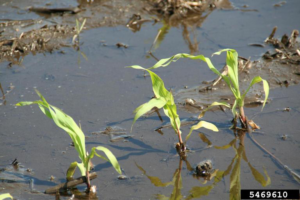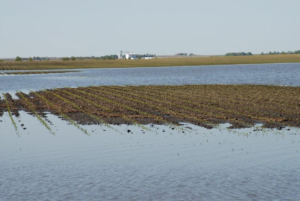Key Points
- Flooding in corn fields can negatively affect yield potential and cause other problems.
- Plant survival, potential nitrogen loss, and soil crusting should be considered when deciding on management options.
- Farmers may re-seed poor stands with corn or soybeans if timely, soils are fit, and herbicide labels have allowable re-cropping intervals.
Survival of Corn Plants
There are differences among corn products in response to flooding. Generally, germinating seeds will survive for four days. Longer flooding results in lower yields especially at lower nitrogen levels. The effects of flooding on yield potential depend on the growth stage of corn, length of time corn is submerged, and temperature. Corn plants need oxygen to survive, and oxygen is depleted after about 48 hours.1,2 Corn plants at or below the soil surface are at the highest risk of dying when the field is flooded. Submerged seedlings that are at or below the soil surface can survive for 2 to 4 days.2 Emerged corn and corn with a growing point above water have a better chance of survival. Temperature is one of the most critical components of plant survival while the field is flooded. If temperatures are above 77° F, the plant may not survive 24 hours beneath water.1 If temperatures are cooler (<77° F), corn with fewer than six leaves can survive approximately four days of flooding.(1)

Figure 1. Corn younger than the six leaf growth stage can survive four days of flooding.
Daren Mueller, Iowa State University, Bugwood.org.
Potential Flooding
Problems Significant loss of nitrogen (N) through denitrification or leaching can occur in corn fields submerged for more than two days. Saturated soils result in denitrification, which tends to be more prevalent in heavier-textured soils, whereas leaching is more prevalent in sandy soils. Soil moisture can increase N losses due to denitrification. Research conducted in Nebraska indicated approximately a 10 to 25% nitrate loss when soil is saturated for 5 and 10 days, respectively.3 This was reported while soil temperatures were between 55 and 60° F. Sidedressing more N is a possible solution if considerable N was lost in the field. As wet soils dry, the soil surface can form a crust potentially inhibiting seedling emergence. Fields may be at greater risk for soil crusting if they have:
- Fine textured soils,
- Low organic matter,
- Little surface residue, and
- Excessive tillage.(4)
A rotary hoe can help break up the crust and aid seedling emergence. Timing is essential, and breaking the crust as soon as possible is most beneficial. Without disease infection, cooler soils can allow seedlings to survive longer as they break through the crust.
Scouting and Replanting Options
It is important to scout corn fields 3 to 5 days after the water has receded.1,2 Pull up seedlings and look at the growing point. A white or cream-colored growing point that is still firm means the plant is recovering. Growing points that are darkening and soft are beginning to die.2 Stand counts need to be taken to determine plant population.
Several options are available if a field needs to be replanted. Guidance can be obtained from the corn (growing degree days) GDD Tool at located at High Plains Regional Climate Center (HPRCC), https://hprcc.unl.edu/agroclimate/gdd.php. It will provide GDD for any location in the Midwest for any starting date and end date. In addition, forecasts are provided using historical data for physiological maturity in relation to corn product relative maturity that can help determine the best relative maturity choice for replanting.
If replanting with corn, minimum or no tillage is recommended to maintain the efficacy of any herbicides and/or soil insecticides already applied to the field. Switching to alternative crops when replanting corn fields must be carefully considered. Before replanting with soybeans, check your herbicide label and consult local experts to determine if the previously applied corn herbicides could damage the replanted crop. It is important to scout fields entirely before making the decision to replant.

